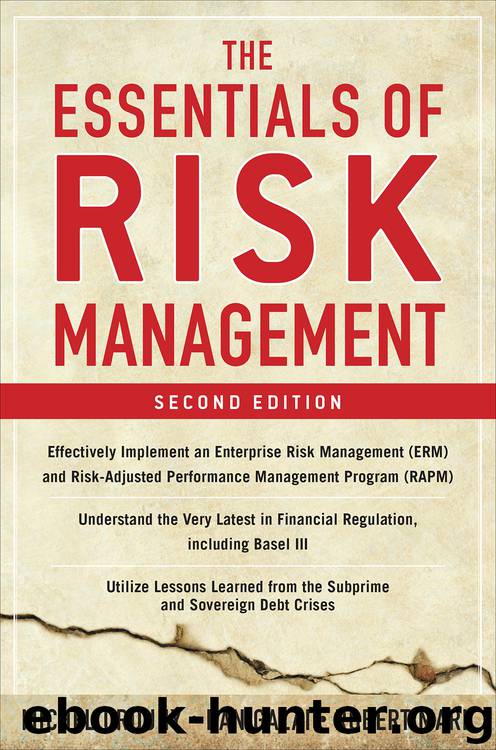The Essentials of Risk Management, Second Edition by Michel Crouhy Dan Galai Robert Mark

Author:Michel Crouhy, Dan Galai, Robert Mark
Language: eng
Format: epub
Published: 2019-04-15T16:00:00+00:00
The Danger of Names
So far, we’ve been discussing risk in terms of its expected and unexpected nature. We can also divide up our risk portfolio according to the type of risk that we are running. In this book, we follow the latest regulatory approach in the global banking industry to highlight three major broad risk categories that are controllable and manageable:
Market risk is the risk of losses arising from changes in market risk factors. Market risk can arise from changes in interest rates, foreign exchange rates, or equity and commodity price factors. 3
Credit risk is the risk of loss following a change in the factors that drive the credit quality of an asset. These include adverse effects arising from credit grade migration, including default, and the dynamics of recovery rates.
Operational risk refers to financial loss resulting from a host of potential operational breakdowns that we can think in terms of risk of loss resulting from inadequate or failed internal processes, people, and systems, or from external events (e.g., frauds, inadequate computer systems, a failure in controls, a mistake in operations, a guideline that has been circumvented, or a natural disaster).
Understanding the various types of risk is important, beyond the banking industry, because each category demands a different (but related) set of risk management skills. The categories are often used to define and organize the risk management functions and risk management activities of a corporation. We’ve added an appendix to this chapter that offers a longer and more detailed family tree of the various types of risks faced by corporations, including key additional risks such as liquidity risk and strategic risk. This risk taxonomy can be applied to any corporation engaged in major financial transactions, project financing, and providing customers with credit facilities.
The history of science, as well as the history of management, tells us that classification schemes like this are as valuable as they are dangerous. Giving a name to something allows us to talk about it, control it, and assign responsibility for it. Classification is an important part of the effort to make an otherwise ill-defined risk measurable, manageable, and transferable. Yet the classification of risk is also fraught with danger because as soon as we define risk in terms of categories, we create the potential for missed risks and gaps in responsibilities—for being blindsided by risk as it flows across our arbitrary dividing lines.
For example, a sharp peak in market prices will create a market risk for an institution. Yet the real threat might be that a counterparty to the bank that is also affected by the spike in market prices will default (credit risk), or that some weakness in the bank’s systems will be exposed by high trading volumes (operational risk). If we think of price volatility in terms of market risk alone, we are missing an important factor.
We can see the same thing happening from an organizational perspective. While categorizing risks helps us to organize risk management, it fosters the creation of “silos” of expertise that
Download
This site does not store any files on its server. We only index and link to content provided by other sites. Please contact the content providers to delete copyright contents if any and email us, we'll remove relevant links or contents immediately.
International Integration of the Brazilian Economy by Elias C. Grivoyannis(90731)
The Radium Girls by Kate Moore(11921)
Turbulence by E. J. Noyes(7935)
Nudge - Improving Decisions about Health, Wealth, and Happiness by Thaler Sunstein(7615)
The Black Swan by Nassim Nicholas Taleb(7010)
Rich Dad Poor Dad by Robert T. Kiyosaki(6399)
Pioneering Portfolio Management by David F. Swensen(6226)
Man-made Catastrophes and Risk Information Concealment by Dmitry Chernov & Didier Sornette(5921)
Zero to One by Peter Thiel(5684)
Secrecy World by Jake Bernstein(4643)
Millionaire: The Philanderer, Gambler, and Duelist Who Invented Modern Finance by Janet Gleeson(4374)
The Age of Surveillance Capitalism by Shoshana Zuboff(4209)
Skin in the Game by Nassim Nicholas Taleb(4161)
Bullshit Jobs by David Graeber(4094)
The Money Culture by Michael Lewis(4074)
Skin in the Game: Hidden Asymmetries in Daily Life by Nassim Nicholas Taleb(3929)
The Dhandho Investor by Mohnish Pabrai(3698)
The Wisdom of Finance by Mihir Desai(3650)
Blockchain Basics by Daniel Drescher(3496)
